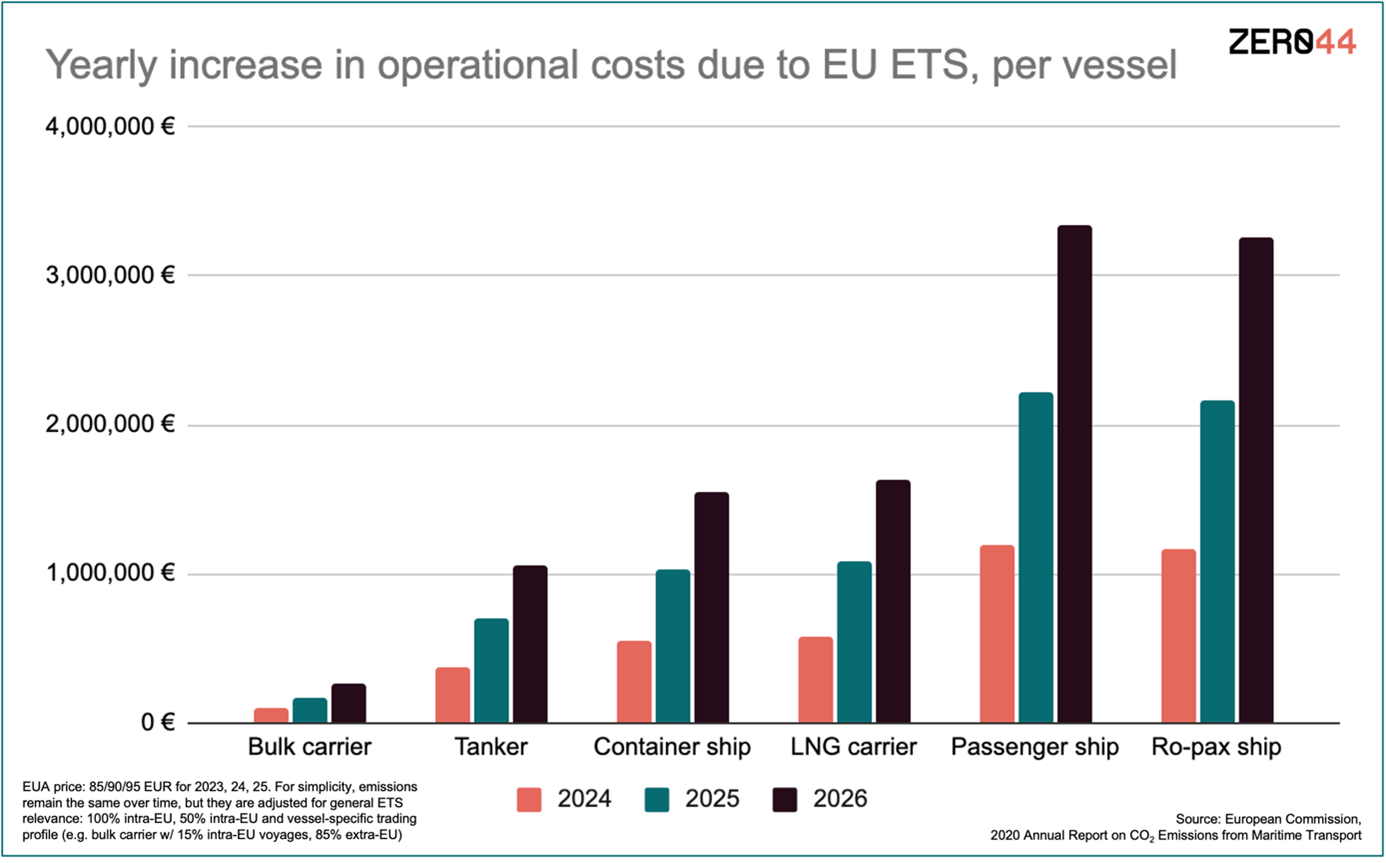
In July 2021, the European Commission proposed to integrate maritime transportation into the EU Emissions Trading System (ETS) in order to cover greenhouse gas emissions from ships calling at EU ports. As part of the “Fit for 55” package, this change aims to help the EU reach net-zero GHG emissions by 2050. By putting a price on carbon and lowering emissions every year, the EU ETS provides financial incentives for stakeholders to reduce their carbon footprint, since polluters must surrender emission certificates, which cost around €90 at present.
In the EU ETS, all emissions from vessels above 5,000 GT calling at EU ports for voyages within the EU (intra-EU), 50% of emissions from voyages that start or end outside of the EU (extra-EU voyages), and all emissions generated when ships are berthed in EU ports will be included. The final rule has not yet been fully agreed upon, but EU institutions reached a preliminary agreement in December 2022. Considering the final rule is merely a formality and agreed this year, the first monitoring year is 2024:
- With 40% of MRV-verified emissions required to be surrendered in 2024, 70% in 2025, and 100% from 2026 onwards, the maritime industry will gradually be integrated into the EU ETS.
- By 2026, general cargo and offshore vessels between 400 and 5,000 GT will be incorporated into MRV and integrated into the EU ETS.
- The EU ETS will apply to large offshore vessels > 5,000 GT starting in 2027, and MRV will be required starting in 2025.
Experts argue that the financial impacts for end users will be minimal, as Sofie Defour, freight director at Transport and Environment, a Brussels-based think tank, told Deutsche Welle: “We found that about 3 cents would be added to the price of your TV and about 8 cents to the price of Nikes.” It is, however, very likely that the EU ETS will have significant impacts on shipping companies.
For example, the operating costs of an average bulk vessel, aged 10 years and emitting ~16,000 tons of CO2 per year, would increase by €1.3m in 2026, assuming it trades only between EU ports. Depending on the underlying cost of the emission certificates, these costs might rise dramatically.
Different types of vessels have different financial implications because of the different regions they sail in and the different CO2 emission profiles they have. A relatively recent EU MRV report analyzing CO2 emissions from maritime transport gives the following picture:
- In 2026, the EU ETS will on average increase operational costs per container vessel per year by €550,000 in 2024 and by €1.4m in 2026.
- By 2026, bulk carriers with MRV data showing 15% intra-EU voyages and 85% extra-EU voyages will face additional operational costs of €260,000 per vessel.
- The EU ETS will result in an increase in operational costs of €1m per tanker in 2026, and €380,000 already in 2024.

Legislators and industry participants are still debating which stakeholder will ultimately bear the increased costs from EU ETS. Considering that the EU ETS is based on the “polluter pays principle”, it is reasonable to expect that, for example, time charter agreements will require the charterer to bear ETS costs. Bimco follows this notion with its ETS allowance clause for time charter parties. Also, industry participants might want to follow Maersk and MSC, which have already communicated ETS surcharges that will be passed on across the value chain.
Operators of smaller fleets, however, will see their operating expenses significantly increase once the ETS comes into force in 2024. It is possible that these players, who are essential to the operation of maritime transport, are less able to implement energy efficiency measures. They might not always be able to just pass on costs to others, due to their individual business models, nor are they able to leverage different emissions profiles across their fleet in order to limit their exposure to the EU ETS.
In order to stay ahead of the game, shipowners should not wait until the last minute before the EU ETS takes effect, but rather use digital tools available now to understand their exposure to ETS while at the same time taking care of getting access to the emission certificate market so they are prepared to purchase, hedge, and trade certificates, whether for themselves, their DoC holders, or their charterers.
Friederike Hesse is Co-Founder and Managing Director of software company zero44
Copyright © 2023. All rights reserved. Seatrade, a trading name of Informa Markets (UK) Limited.






